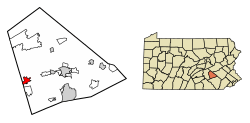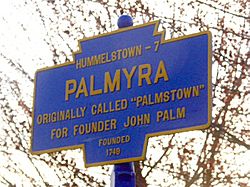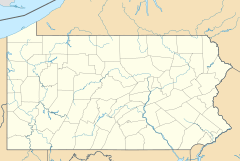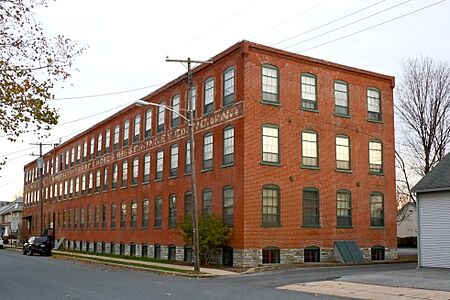Palmyra, Pennsylvania facts for kids
Quick facts for kids
Palmyra, Pennsylvania
Pallemschteddel
|
||
|---|---|---|
|
Borough
|
||

Downtown Palmyra
|
||
|
||

Location in Lebanon County, Pennsylvania
|
||
| Country | ||
| State | ||
| County | Lebanon | |
| Settled | 1717 | |
| Incorporated (borough) | 1913 | |
| Area | ||
| • Total | 1.93 sq mi (4.99 km2) | |
| • Land | 1.92 sq mi (4.98 km2) | |
| • Water | 0.00 sq mi (0.01 km2) | |
| Elevation | 456 ft (139 m) | |
| Population
(2020)
|
||
| • Total | 7,830 | |
| • Density | 4,071.76/sq mi (1,572.31/km2) | |
| Time zone | UTC-5 (Eastern (EST)) | |
| • Summer (DST) | UTC-4 (EDT) | |
| ZIP code |
17078
|
|
| Area code(s) | 717 and 223 | |
| FIPS code | 42-57720 | |
Palmyra is a small town, called a borough, in Lebanon County, Pennsylvania, United States. People who speak Pennsylvania German sometimes call it Pallemschteddel. It's part of the wider Lebanon area. In 2020, about 7,807 people lived there.
Contents
Where is Palmyra?
Palmyra is located in the Lebanon Valley. It sits between two other towns, Annville and Hershey. It's on the western side of Lebanon County.
The borough is about 10 miles (16 km) west of Lebanon. It's also about 17 miles (27 km) east of Harrisburg. The nearby village of Campbelltown is just 2 miles (3 km) south.
Palmyra covers about 1.9 square miles (4.9 square kilometers) of land. While no big rivers run through the town, several creeks are close by. These include Killinger, Quittapahilla, Spring, and Swatara Creeks. Palmyra has a climate with warm summers and cold winters.
Understanding Palmyra's Ground
A geologist named William E. Kochanov studied the ground in Palmyra. He found that the type of rock and soil there causes many sinkholes. Sinkholes are holes that open up in the ground.
Palmyra is in the eastern part of a large valley called the Great Valley. The ground under Palmyra is made of a rock type called Ordovician Epler Formation. This type of ground often has many dips and sinkholes. These natural holes help water drain away into underground water sources.
However, as Palmyra grew, buildings and roads changed these natural drainage paths. Now, storm water often flows in ways that cause more sinkholes. In 1993, people in Palmyra talked about fixing these problems. They thought about building a new storm sewer system. Since then, some projects have helped manage the water flow better.
Palmyra's Past: A Look Back
Early Settlers and Native Americans
Long ago, the land where Palmyra is now was home to the Lenape and Susquehannock Native American tribes. Around 1650, the first European explorers came to this area. Settlers were drawn here because of the rich land. There was also plenty of fish and game.
The area was part of William Penn’s colony. Penn's colony offered civil rights and religious freedom. This attracted many people seeking a new life. Between 1717 and 1740, some settlers came and built homes without official land papers. They were called squatters.
The first European settlers near Palmyra came from two main groups. These were the Scotch-Irish and the German Palatinates.
The Scotch-Irish left their homes for political, economic, and religious reasons. They often stayed together and were interested in local government. Many were Presbyterian and built churches as they moved west. Over time, many Scotch-Irish families moved further west from the Lebanon Valley.
Some of the early Scotch-Irish families in Palmyra included Aspey, Campbell, and McClure.
The German Palatinates also left their homes for similar reasons. They faced hardship and religious persecution. Like the Scotch-Irish, Germans tended to stick together. German was a common language in Pennsylvania. This encouraged more German settlers to come. Most Germans were farmers. They were known for being hardworking and religious. Unlike the Scotch-Irish, most Germans stayed in Pennsylvania to farm the rich soil.
Some of the early German families in Palmyra included Bindnagle, Bowman, and Zimmerman.
Protecting the Frontier
The western edge of the European colonies, including the Palmyra area, faced attacks from Native American tribes. In 1756, the government decided to build a line of forts. These forts stretched from the Susquehanna River to the Delaware River. They were about 10 to 15 miles (16 to 24 km) apart.
One of these forts was Fort Swatara. It was built near modern-day Inwood. After the French and Indian War ended in 1763, Native American attacks became less frequent.
Johannes Palm, also known as John Palm, is credited with founding Palmyra. He was a doctor and a soldier in the Revolutionary War. In 1766, Palm bought 100 acres of land. By 1776, he had plans for a settlement called "Palmstown." His home was on West Main Street.
How Palmstown Grew into Palmyra
The town's Post Office opened on April 1, 1804. The name sent to the Postal Service was "Palmstown." But by 1806, people started calling the settlement "Palmyra." This name likely came from the ancient Roman city of Palmyra in Syria. Both names were used for a while. By 1810, "Palmyra" became the official name.
Good roads were important for towns to grow. Companies built turnpikes, which were toll roads, to improve travel. The Berks and Dauphin Turnpike opened in 1817. This road connected Reading and Hummelstown. It ran right through Palmyra. This gave Palmyra a direct link to nearby towns like Annville and Hershey. It also connected Palmyra to bigger markets in eastern Pennsylvania. This turnpike was a toll road until 1917. Today, it's part of US 422.
Another important road, the Horseshoe Pike, was completed in 1819. It ran through Campbelltown, just south of Palmyra. This road later became part of US 322. With more roads, more travelers came through Palmyra. This led to new taverns and hotels being built. Blacksmith shops, general stores, and other small businesses also opened.
Later, the Union Canal was built. It opened in 1827. The canal connected the Schuylkill River to the Susquehanna River. It passed just north of Palmyra. This helped the town by increasing trade. In 1857, trains also came to Palmyra. The first locomotives ran on the Lebanon Valley Railroad. The growth of trains meant less use for the canal and toll roads.
Palmyra After the Civil War
Palmyra continued to grow steadily. In 1845, about 160 people lived there. By 1875, the population grew to 500. By 1890, it jumped to 1,760 people. By 1960, about 7,000 people lived in Palmyra.
When the Civil War began in 1861, about 78 men from Palmyra joined the Union Army. After the war ended in 1865, many new businesses started in Palmyra. These included a grain warehouse, a slaughterhouse, and a lumber mill. The town's first newspaper, "The Londonderry Gazette," was printed in 1878. The Palmyra Bank opened in 1887.
Several shoe factories opened in the late 1800s. Other businesses included a knitting mill, a paper box factory, and a bakery. The growth of Milton S. Hershey’s chocolate company nearby also brought more people to Palmyra.
In 1899, a trolley line was formed to connect towns in Lebanon County. The trolley reached Palmyra in 1904. The Hershey Trolley Company also connected to this line in Palmyra. These trolleys helped people travel until the 1930s and 1940s, when bus services took over.
The Landis Shoe Company Building is an important historical site in Palmyra. It was added to the National Register of Historic Places in 1980.
Palmyra's 250th Anniversary
In 2010, Palmyra celebrated its 250th anniversary. A special committee planned the celebration. They chose an official logo for the event. The logo was inspired by the Pennsylvania state seal. It used the orange and black colors of the Palmyra School District. You can find more information on the official anniversary website: https://web.archive.org/web/20101222111821/http://palmyra250.com/.
Palmyra's People
| Historical population | |||
|---|---|---|---|
| Census | Pop. | %± | |
| 1880 | 531 | — | |
| 1890 | 768 | 44.6% | |
| 1920 | 3,646 | — | |
| 1930 | 4,377 | 20.0% | |
| 1940 | 5,239 | 19.7% | |
| 1950 | 5,910 | 12.8% | |
| 1960 | 6,999 | 18.4% | |
| 1970 | 7,615 | 8.8% | |
| 1980 | 7,228 | −5.1% | |
| 1990 | 6,910 | −4.4% | |
| 2000 | 7,096 | 2.7% | |
| 2010 | 7,320 | 3.2% | |
| 2020 | 7,807 | 6.7% | |
| 2021 (est.) | 7,755 | 5.9% | |
| Sources: | |||
In 2000, there were 7,096 people living in Palmyra. There were 3,200 households. About 47.7% of households were married couples. About 25.9% of households had children under 18.
The population included people of different backgrounds. Most residents were White. There were also African American, Native American, and Asian residents. Some people identified as Hispanic or Latino.
Learning in Palmyra
Early Schools and Growth
The first two free public schools in Palmyra opened in 1840. Before that, children went to church schools or private schools. The Palmyra Academy, also called the Witmer Academy, opened in 1857. It was known as one of the best schools in the area. It helped students get ready for college.
The Palmyra Academy taught students from all over the Susquehanna Valley. It closed in 1890. The building was taken down nine years later.
The Palmyra Area School District
As Palmyra grew, a new government for the borough was formed. The Palmyra Borough School District was created in 1913. The first school building for the district opened on South Railroad Street in 1915. A new school for grades seven through twelve was built in 1937.
In 1952, the schools of Palmyra Borough and North Londonderry Township decided to work together. Three years later, they joined to form the Palmyra Area School District. In 1962, schools from South Londonderry Township also joined the district.
Today, the Palmyra Area School District serves Palmyra Borough. It also serves North and South Londonderry Townships. This includes the villages of Campbelltown, Lawn, and Timber Hills. The Palmyra Area School District has four elementary schools. It also has one middle school and one high school. Most school buildings are in Palmyra Borough. The high school and one elementary school are just outside the borough limits.
See also
 In Spanish: Palmyra (Pensilvania) para niños
In Spanish: Palmyra (Pensilvania) para niños







